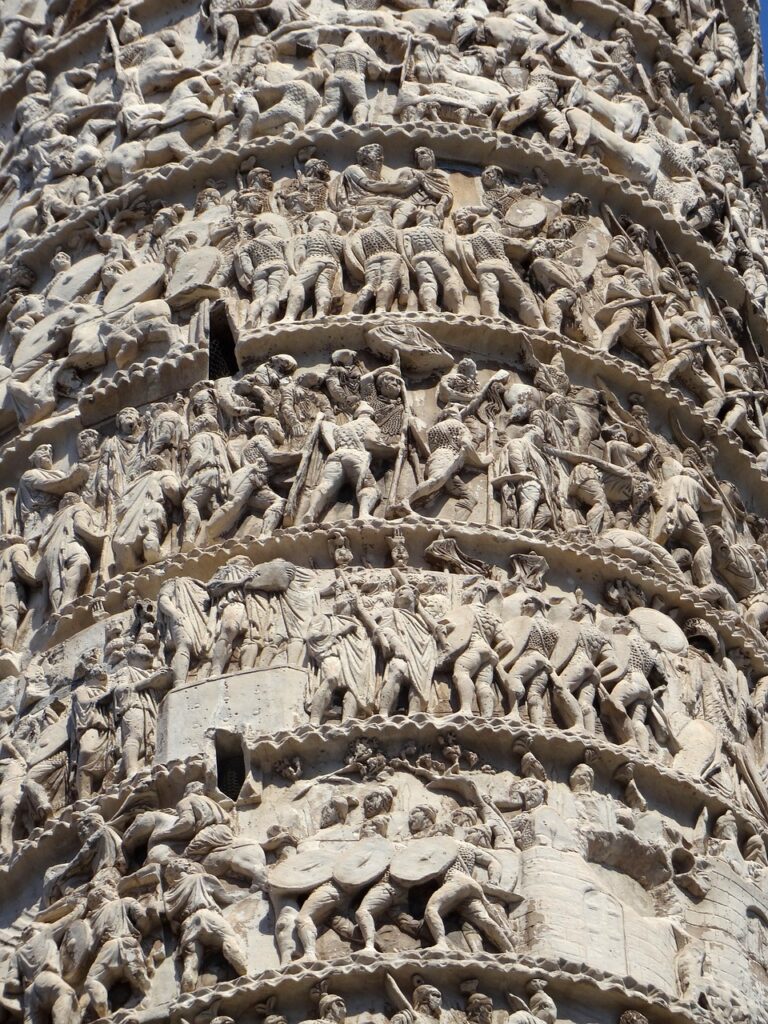Standing proudly in the heart of Rome, Italy, Trajan’s Column is a monumental structure that has captivated visitors for centuries. Its towering presence and rich history make it one of the most iconic landmarks of ancient Rome. But what exactly is Trajan’s Column, and why is it so significant? Let’s delve deeper into the story behind this remarkable monument.
Origins and Construction
Trajan’s Column was commissioned by the Roman Emperor Trajan to commemorate his victorious campaigns in the Dacian Wars, which took place between 101 and 106 AD. These military campaigns aimed to expand the Roman Empire into the territory of present-day Romania, then known as Dacia. The column was designed by the renowned architect Apollodorus of Damascus and was constructed between 107 and 113 AD, shortly after the conclusion of the wars.
Crafted from solid Carrara marble, Trajan’s Column stands at an impressive height of 30 meters (about 98 feet) and weighs an estimated 1,110 tons. Its construction required the transportation of large marble blocks from quarries in Carrara, Italy, to Rome, where skilled artisans meticulously carved the intricate designs into the surface of the column.
The column consists of 29 massive marble drums stacked on top of each other, with a diameter of approximately 3.7 meters (about 12 feet) at the base. Each drum weighs between 32 and 77 tons and was carefully hoisted into place using a system of pulleys and cranes. The exterior of the column is adorned with a continuous spiral frieze that winds its way from the base to the top, depicting scenes from Trajan’s military campaigns in intricate detail.
The Spiral Frieze
The spiral frieze of Trajan’s Column is a masterpiece of ancient Roman artistry and storytelling. Stretching for over 200 meters (about 656 feet) and containing more than 2,500 individual figures, the frieze offers a vivid portrayal of the Dacian Wars. The scenes depicted include battles, sieges, marches, and other military activities, providing viewers with a comprehensive narrative of Trajan’s conquest of Dacia.
The carvings on the frieze are remarkably detailed, with soldiers depicted wearing intricate armor and weapons, horses in full gallop, and fortifications under siege. Each scene is meticulously arranged in chronological order, allowing viewers to follow the progression of the war as they ascend the column. Scholars believe that the frieze was originally painted in vibrant colors, further enhancing its visual impact.

Symbolism and Narrative
Beyond its artistic beauty, the spiral frieze serves a symbolic and narrative purpose. It not only celebrates Trajan’s military victories but also reinforces his status as a triumphant and virtuous leader. The scenes depicted on the frieze emphasize themes of courage, heroism, and Roman superiority, glorifying the Roman Empire’s expansion and dominance over its enemies.
Moreover, the frieze immortalizes the achievements of the Roman army and pays tribute to the soldiers who fought and sacrificed their lives in service to the empire. It serves as a visual record of historical events, preserving the memory of Trajan’s conquest of Dacia for future generations to admire and study.
Architectural Innovation
In addition to its artistic and historical significance, Trajan’s Column is admired for its architectural ingenuity. One of the most remarkable features of the column is its interior spiral staircase, which winds its way up to a platform at the top. This staircase allowed visitors in ancient times to climb to the summit of the column and enjoy panoramic views of the surrounding city.
The spiral staircase is a marvel of ancient engineering, designed to support the weight of thousands of visitors while maintaining the structural integrity of the column. It is constructed from a series of marble slabs that are held together with iron rods, creating a sturdy and durable framework. Although the staircase is no longer accessible to the public due to safety concerns, it remains a testament to the advanced building techniques employed by the Romans.
Preservation and Legacy
Despite being over 1,900 years old, Trajan’s Column has survived remarkably well over the centuries. It has undergone several restoration projects to repair damage caused by natural wear and tear, pollution, and other environmental factors. In 1987, Trajan’s Column was inscribed as a UNESCO World Heritage Site, recognizing its cultural significance and historical importance.
Today, Trajan’s Column continues to stand as a symbol of Rome’s imperial past and is a popular tourist attraction in the city. Visitors from around the world come to marvel at its intricate carvings, learn about ancient Roman history, and experience the grandeur of the Roman Empire firsthand.